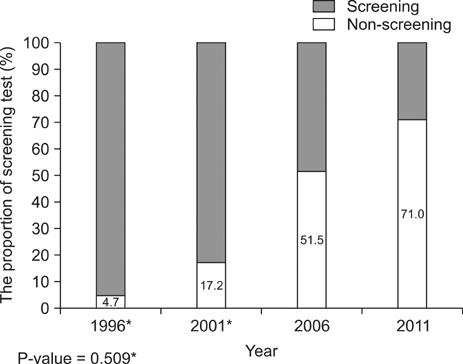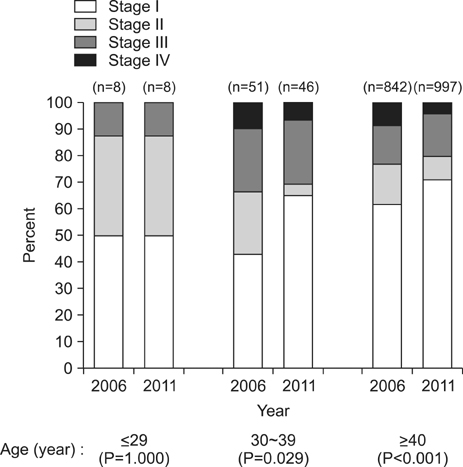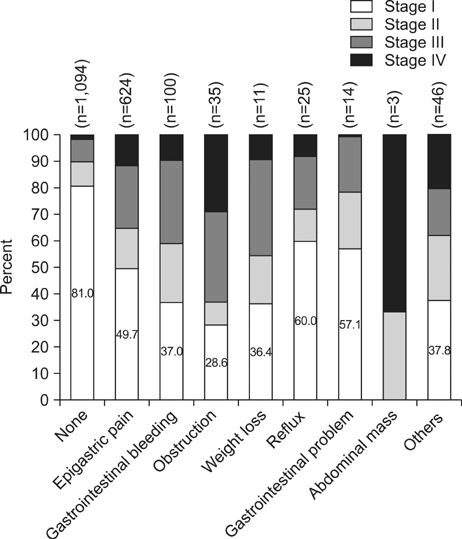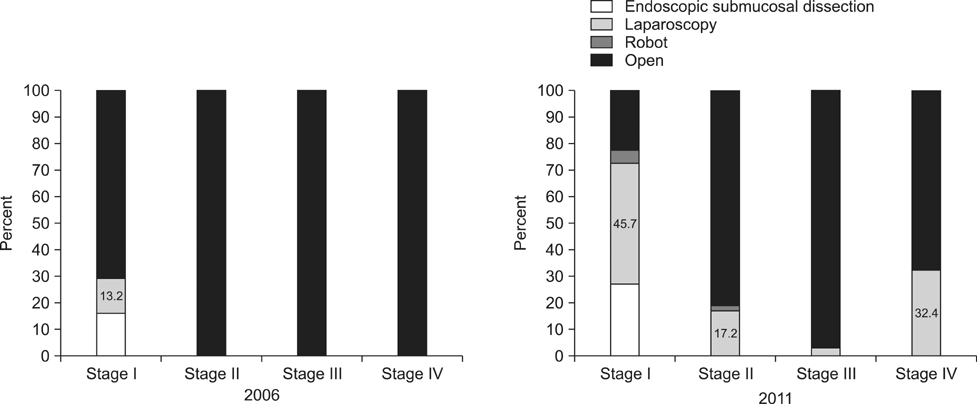J Gastric Cancer.
2014 Jun;14(2):129-134.
Effects of Screening on Gastric Cancer Management: Comparative Analysis of the Results in 2006 and in 2011
- Affiliations
-
- 1Department of Surgery, Seoul National University College of Medicine, Seoul, Korea. wisehearted@gmail.com
- 2Department of Internal Medicine, Liver Research Institute, Seoul National University College of Medicine, Seoul, Korea.
- 3Department of Pathology, Seoul National University College of Medicine, Seoul, Korea.
- 4Cancer Research Institute, Seoul National University, Seoul, Korea.
Abstract
- PURPOSE
This study aimed to analyze the effect of screening by using endoscopy on the diagnosis and treatment of gastric cancer.
MATERIALS AND METHODS
The clinicopathologic characteristics of gastric cancer were compared in individuals who underwent an endoscopy because of symptoms (non-screening group) or for screening purposes (screening group). The distributions of gastric cancer stages and treatment modalities in 2006 and 2011 were compared.
RESULTS
The proportion of patients in the screening group increased from 45.1% in 2006 to 65.4% in 2011 (P<0.001). The proportion of stage I cancers in the entire patient sample also increased (from 60.5% in 2006 to 70.6% in 2011; P=0.029). In 2011, the percentages of patients with cancer stages I, II, III, and IV were 79.9%, 8.2%, 10.9%, and 1.1%, respectively, in the screening group, and 47.9%, 10.8%, 29.8%, and 11.5%, respectively, in the non-screening group. The proportion of laparoscopic and robotic surgeries increased from 9.6% in 2006 to 48.3% in 2011 (P<0.001), and endoscopic submucosal dissection increased from 9.8% in 2006 to 19.1% 2011 (P<0.001).
CONCLUSIONS
The proportion of patients diagnosed with gastric cancer by using the screening program increased between 2006 and 2011. This increase was associated with a high proportion of early-stage cancer diagnoses and increased use of minimally invasive treatments.
Figure
Reference
-
1. Ferlay J, Shin HR, Bray F, Forman D, Mathers C, Parkin DM. Estimates of worldwide burden of cancer in 2008: GLOBOCAN 2008. Int J Cancer. 2010; 127:2893–2917.
Article2. Jing JJ, Liu HY, Hao JK, Wang LN, Wang YP, Sun LH, et al. Gastric cancer incidence and mortality in Zhuanghe, China, between 2005 and 2010. World J Gastroenterol. 2012; 18:1262–1269.
Article3. Ministry of Health and Welfare. Annual report of the Korea Central Cancer Registry 2008 [Internet]. Sejong: Ministry of Health and Welfare;2008. cited 2012 Feb 13. Abailable from: www.mw.go.kr.4. Lambert R, Guilloux A, Oshima A, Pompe-Kirn V, Bray F, Parkin M, et al. Incidence and mortality from stomach cancer in Japan, Slovenia and the USA. Int J Cancer. 2002; 97:811–818.
Article5. Chung SJ, Park MJ, Kang SJ, Kang HY, Chung GE, Kim SG, et al. Effect of annual endoscopic screening on clinicopathologic characteristics and treatment modality of gastric cancer in a high-incidence region of Korea. Int J Cancer. 2012; 131:2376–2384.
Article6. Nam SY, Choi IJ, Park KW, Kim CG, Lee JY, Kook MC, et al. Effect of repeated endoscopic screening on the incidence and treatment of gastric cancer in health screenees. Eur J Gastroenterol Hepatol. 2009; 21:855–860.
Article7. Gong EJ, Ahn JY, Jung HY, Lim H, Choi KS, Lee JH, et al. Risk factors and clinical outcomes of gastric cancer identified by screening endoscopy: a case-control study. J Gastroenterol Hepatol. 2014; 29:301–309.
Article8. Lee EH, Lee HY, Choi KS, Jun JK, Park EC, Lee JS. Trends in cancer screening rates among korean men and women: results from the Korean National Cancer Screening Survey (KNCSS), 2004-2010. Cancer Res Treat. 2011; 43:141–147.
Article9. Kong SH, Park DJ, Lee HJ, Jung HC, Lee KU, Choe KJ, et al. Clinicopathologic features of asymptomatic gastric adenocarcinoma patients in Korea. Jpn J Clin Oncol. 2004; 34:1–7.
Article10. Park B, Choi KS, Lee YY, Jun JK, Seo HG. Trends in cancer screening rates among Korean men and women: results from the Korean National Cancer Screening Survey (KNCSS), 2004-2011. Cancer Res Treat. 2012; 44:113–120.
Article11. González N, Parra-Blanco A, Villa-Gómez M, Gamba A, Taullard A, Silveira A, et al. Gastric endoscopic submucosal dissection: from animal model to patient. World J Gastroenterol. 2013; 19:8326–8334.
Article12. Jee YS. First experiences with laparoscopic assisted distal gastrectomy: in the view of comparison with high volume centers. J Korean Surg Soc. 2012; 83:130–134.
Article13. Park KK. Laparoscopic surgery for gastric cancer. Korean J Gastroenterol. 2005; 45:9–16.14. Song KY. The current status and future perspectives of laparoscopic surgery for gastric cancer. Korean J Gastroenterol. 2007; 50:233–241.15. Suh YS, Han DS, Kong SH, Kwon S, Shin CI, Kim WH, et al. Laparoscopy-assisted pylorus-preserving gastrectomy is better than laparoscopy-assisted distal gastrectomy for middle-third early gastric cancer. Ann Surg. 2014; 259:485–493.
Article






